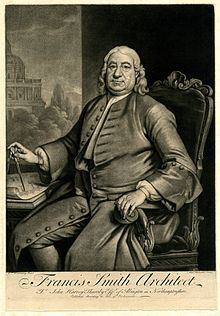Name Francis of Died 1738 | Role Architect | |
 | ||
Structures Similar People James Gibbs, Nancy Lancaster, John Soane | ||
Francis Smith of Warwick (1672–1738) was an English master-builder and architect, much involved in the construction of country houses in the Midland counties of England. Smith of Warwick may refer also to his brothers, or his son.
Contents
The architectural work
The county town of Warwick had been devastated by a fire in September 1694, and the projects involved in its rebuilding gave the Smith brothers their first prominence, which they retained for decades by a universal reputation for scrupulous honesty and competence. Howard Colvin, plotting their known commissions on a map, remarked that nearly all of them lay within a fifty-mile radius of their mason's yard, the "Marble House" in Warwick.
The antiquary the Hon. Daines Barrington noted in 1784, after viewing several Smith of Warwick houses, found "all of them convenient and handsome" despite changes in taste, but that "there is a great sameness in the plans, which proves he had but little Invention." Colvin summarised the elements by which a Smith house is easily recognizable: three storeys, with the central three bays emphasized by a slight projection or recession; uniform fenestration with exterior detail confined to keystones, architraves, quoins and a balustraded parapet, which was the most significant modernisation of a formula derived in essence from the late seventeenth-century model typified by Belton House. In the plans there was invariably a hall backed by a saloon in the centre, with a staircase set to one side. In spite of some splendid effects achieved by plasterwork and joinery, Colvin noted that "the spatial effects are simple and unenterprising".
Four exceptional houses did not conform to these conventions. They were Kedleston (demolished and replaced by the celebrated Robert Adam house; Chicheley Hall with William Kent, doubtless in part the design of its owner Sir John Chester, and his virtuosi friends; Stoneleigh Abbey, "a somewhat inept attempt to use a giant order in the grand baroque manner" (Colvin) and Sutton Scarsdale (stripped of its interiors in the 1920s), where Colvin, comparing its assurance with Stoneleigh's "gauche" crowded windows and "leggy pilasters", suspected some intervention by James Gibbs.
Family
William Smith of Warwick (1661-1724), master builder trained as a bricklayer, was his brother: the brothers, who often worked in partnership and with the third brother Richard, were sons of a bricklayer and master builder, Francis Smith, of The Wergs, near Tettenhall, Staffordshire. By the time of William's death in 1724 they had become the most prominent designers and builders of houses in the Midlands.
William Smith of Warwick (1705-1747) was the next generation in the firm, son of Francis. The business passed to William and David Hiorn.
Craftsmen
He was a major employer, and some of his craftsmen were individually credited on a lead plaque formerly at Sutton Scarsdale:
Another craftsman and architect who worked under Smith was William Baker of Audlem, who was employed as a carpenter by Smith at Ditchley in Oxfordshire in 1727, and later developed an extensive architectural practice in Shropshire and Staffordshire
